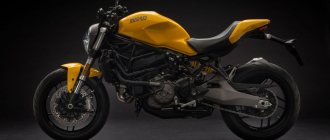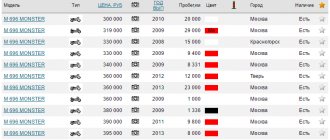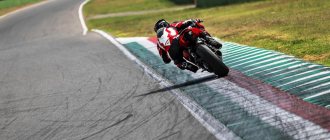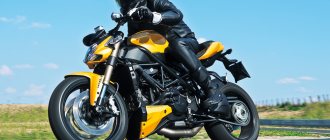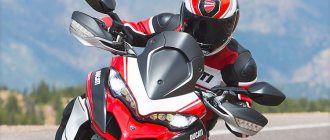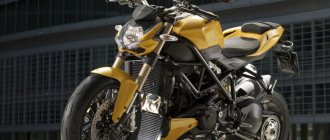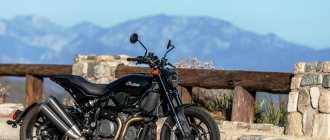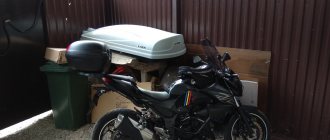New Monster
Driving Modes
Ducati's riding modes are undoubtedly a milestone in motorcycle design, allowing riders to select Sport, Touring and Urban settings that optimize the bike's performance to suit individual riding style and varying road conditions. Each driving mode has been designed to instantly change engine characteristics (power modes) and intervention levels of ABS, DTC and DWC systems, even while driving.
Sport driving mode
The engine develops a power of 111 hp. With. with direct throttle control by Ride-by-Wire, reduced intervention by Ducati Traction Control, second-level ABS braking performance and moderate rear wheel lift control. The level of intervention of the Ducati Wheelie Control system improves the riding experience in sport mode.
Touring driving mode
The engine develops a power of 111 hp. With. with more progressive throttle control by the Ride-by-Wire system, an increased level of intervention from Ducati Traction Control and a third level of braking performance from the ABS system, which provides maximum braking stability and moderate control of rear wheel lift. Ducati Wheelie Control is tuned to the optimal level to ensure a relaxed ride.
Urban driving mode
The engine develops a power of 75 hp. With. with progressive throttle control by Ride-by-Wire, an even higher level of intervention by Ducati Traction Control and a third level of ABS that ensures maximum braking stability and eliminates rear wheel lift.
Ducati Quick Shift (DQS)
The electronic Ducati Quick Shift (DQS) system is available as standard on the new Monster. This system is developed using experience from the world of motorcycle racing and allows you to change gears without using the clutch. Ducati Quick Shift not only makes sporty driving more fun, but also helps when driving around town or on winding roads where frequent gear changes are required.
Instrument panel with color TFT display
The Monster's instrument panel features a 4.3-inch TFT color display. The graphic design inherited from the Panigale V4 provides all the necessary information. The tachometer and the currently selected gear are displayed in the center of the screen. Even the air temperature and fuel level are immediately indicated on the display. This device is also designed to display information from the Ducati Multimedia System (DMS), which allows you to connect a smartphone to the motorcycle via Bluetooth (available as an accessory) and control certain functions using buttons on the handlebars. The display shows music player commands, status icons for the connected headset, information about incoming calls, and notifications about received messages.
Headlight and indicators
Undoubtedly, the round headlight of the new Monster is a successful throwback, a tribute to the past, complemented by the latest LED technology, which is used throughout the lighting system. In addition, Ducati has successfully introduced "running light" technology, namely dynamic turn indicators with automatic shutdown.
Price for Ducati Monster 696
Prices are indicated only for used motorcycles (since they are no longer produced) from 2008 to 2014.
prices on moto.auto
Price for avito
The cost greatly depends on the technical condition and mileage. The average price of a device ranges from 310 to 570 thousand rubles, with the following distribution by year:
- 2008: 330 – 360 thousand rubles.
- 2009: 310 – 380 thousand rubles.
- 2010: 350 – 399 thousand rubles.
- 2013: 350 – 570 thousand rubles.
Despite the fact that the model is not currently in production, it is still popular and in demand.
Read other motorcycle reviews Review of the KTM 690 SMC motorcycle
What makes Ducati motorcycles unique?
Without going into too much detail, there are a few important aspects to understand that make Ducati motorcycles different from others. In addition to its Desmo valve systems, Ducati also uses a so-called "dry clutch". As the name suggests, this is a clutch that is not in an oil bath (and therefore does not suffer from the drag caused by oil) and leaves the component more accessible for maintenance or repair. This setup also helps with heat dissipation, plus it's just great to be able to see the mechanical interaction as the thing spins.
Dry clutches also give Ducati engines an incredibly distinctive rattling sound. This, combined with the L-Twin configuration, makes it very easy to detect the roar of a Ducati engine, even if you can't see it for several blocks.
Ducati Pantah
Ducati also views competition as a form of marketing for its two-wheelers, and racing is therefore intrinsically linked to the brand's roots and identity. The manufacturer has historically incorporated technologies and systems from its racing cars into its road-going production models. And more than 70 years after the release of the first motorcycle, this fact remains relevant today as never before.
When you pay for a Ducati, it's a luxury to get a motorcycle that is loaded with features and equipment designed for racing. Ducati continues to rely heavily on its Grand Prix racing program for cutting-edge research and development. And was the first manufacturer to offer MotoGP-style electronic rider aids such as launch and traction control on a road-going production model. The engine found in Ducati's latest flagship superbike is directly inspired by the V4 engine that has been used by the Ducati Corse team for over a decade.
To sum it up, Ducati motorcycles are largely distinguished by their long-standing racing heritage, unique engine architecture and sound, distinctly oriented character and typically exotic Italian aesthetic design. And while they often boast superior performance, Ducati motorcycles almost always cost more than most of their competitors, which ultimately provides a unique sense of exclusivity that is not found in most Japanese models.
Myths and misconceptions about Ducati reliability
Throughout its modern history, Ducati has produced some undeniably high performance motorcycles. Luckily, Ducati's reliability issues are now largely reflected in their rear view mirrors. Modern Ducatis are no less bulletproof than any other European or Japanese model. Moreover, the current crop of Ducati motorcycles boast of longer service intervals. If you buy a Ducati today, you can honestly expect it to start for you every morning.
However, it's worth noting that Ducati's running costs generally exceed those of their Japanese competitors. Not only is the motorcycle itself more expensive, insurance is more expensive, registration is more expensive, aftermarket parts and accessories are more expensive, and just like with an expensive car.
Early history of the Ducati brand
The company we know today as Ducati Motor was founded in July 1926 by brothers Bruno, Marcello and Adriano Ducati. The latter of whom filed a patent for a shortwave radio transmitter capable of reaching America. Operating under the banner of Società Scientifica Radio Brevetti Ducati in the brothers' native Bologna, the company initially sold radio equipment and achieved significant success in its first decade of activity. Growing from less than half a dozen employees to a huge factory employing hundreds of people.
Unfortunately, the company's size, success, and involvement in the production of equipment used by the nation's armed forces made it a prime target for airstrikes when World War II broke out. And in October 1944, the Ducati radio factory was destroyed by Allied bombing. After the end of the global conflict, growing demand for economical and utilitarian vehicles in their native Italy prompted Ducati to rebuild its plant into an auto company.
Even before the war ended, Ducati began developing a 48 cc single-cylinder four-stroke engine that could be coupled to a bicycle frame. Nicknamed "Cucciolo" (Italian for "puppy") due to the high-pitched exhaust note. Ducati released the clip-on engine in 1946 to an incredibly warm reception from the public. Thanks to the four-stroke cycle configuration and two-speed gearbox, the buyer could make maximum use of 1.5 hp. 48 cc engine, allowing you to reach a speed of about 40 km per hour.
In 1949, the growing Italian company released its first fully equipped motorcycle model, the Ducati 60. The engine was 60 cc. cm, coupled to a three-speed gearbox, produced a whopping 2 hp. The manufacturer continued to prosper, and in 1954 Ducati brought in a young engineer named Fabio Taglioni. Which went on to develop the mechanical architecture and distinctive features that are now closely associated with the company. And eventually became the brand's chief designer and technical specialist. director and held this position until 1989.
One of Fabio Taglioni's many elements was the implementation of the Desmodronic valve system. Instead of using traditional spring-actuated valves, the "Desmo" configuration uses a mechanically actuated system that helps reduce valve displacement at higher rpm. In the modern steel and metallurgical industry, this advantage no longer exists and is used more for the sake of identity and tradition.
Ducati experimented with multi-cylinder engine configurations on its racing motorcycles, although it continued to produce single-cylinder models throughout its existence. In response to models such as Honda's hugely successful CB750, Ducati released the 750 GT, the company's first L-Twin. The L-Twin was essentially just a V-Twin, but due to the angle of the cylinders, the nickname helps differentiate it from the American-made V-Twin.
Ducati has been racing ever since it began making engines, and although the company has enjoyed considerable success, it was not until 1972 that the company really appeared on the radar of the world motorcycle scene when Paul Smart achieved fame piloting the Imola Desmo 750.
From this point on, the L-Twin configuration became Ducati's standard, and every production production model produced since then was equipped with an L-Twin. This has recently changed with the introduction of the flagship V4 platform created by Ducati MotoGP. Although most of the lineup has yet to receive the new four-cylinder powerplant.

